Speaker
Prof.
Robert Lewis
(Monash University, Australia)
Description
The SmartPET is a novel Positron Emission Tomography (PET) system
that uses High Purity Germanium (HPGe) detectors in a dual-head
camera design. Alone, the superior 3D position resolution
o_ered by semi-conductor detectors removes the depth-of-interaction
problem inherent in many PET camera designs. However, there is
another opportunity o_ered by the system. Coincident measurement,
in a single detector, of an interaction sequence arising from the
path of a single photon allows each of the detectors to act
independently as a Compton Scatter Camera (CSC).
The CSC relies on the measurement of the position and energy from
individual inelastic scattering and photo-absorption interactions of
a single incident photon. Measurement of two or more of these
interactions (and knowledge of the incident energy) allow the CSC to
define a Cone-Surface of Response (CSR), along which lies the
incident trajectory of the photon. The resolution of this CSR is
defined entirely by the uncertainty in position and energy in the
measurements of the individual interactions.
The angular resolution of this CSR is defined by the scattering
angle, the spatial and spectral resolutions of the detector, along
with the distance between the first two interactions in the sequence
[1].
The current study proposes the use of these CSR events in the
discrimination of Lines of Response (LoR) in a PET system. Current
PET studies show that up to 36 % of detected events may scatter
inside the object [2], furthermore, in fully 3D PET up to 50 % of
the coincident detections might arise from random coincidence [3].
LoR validation through CSR aquisition o_ers the ability to
discriminate Compton scattered and randomly coincident detections,
without the need to apply scatter correction algorithims nor
implement delay coincidence channels respectivly.
As each of the detectors acts as a standalone CSC, each will acquire
a number of different interaction sequence types, depending on the
number of interactions that an incident photon undergoes. In a
dualhead PET system coincident interaction sequences may be acquired
leading to LoRs. Generally, in order to correctly define a CSC a
knowledge of the incident energy is required. However, for
discrimination purposes, 511keV may be assumed due to the CSC/LoR
relationship requiring that an LoR lie along any associated CSC. If
the assumption is false then a correct match is highly unlikely.
Further, if time resolution is introduced at the interaction
sequence level, then the coincidence of two interaction sequences
in opposing detectors may not be defined uniquely, particularly in a
high activity environment. In this scenario, each interaction
sequence in a timing bin may be interrogated for LoR matching
purposes.
The above validation was performed on co-linear 511 keV photon
events simulated using Geant4. The simulation modeled HPGe detectors
separated by 6-10 cm and a dual source at the center of the
detector geometry. While energy resolution is still required in the
definition of CSRs, the importance of position resolution in this
PET detector design was the main focus of this study. Hence, energy
resolution was initially assumed to be perfect, and the e_ect of
position resolution on the ability of the CSRs to discriminate LoRs
was investigated. CSR discrimination proved successful in removing
both Compton scattered and random coincidences from the data.
Moreover, the importance of positional resolution in CSC detection
in the PET process is highlighted by this study.
These techniques may be used to reduce the number of false LoRs in a
PET image obtained from such a system. It also indicates that the
importance placed on full energy deposit and timing information,
the focus of PET measurement over the past few years, may be reduced.
Primary author
Mr
John Gillam
(Monash University, Australia)
Co-author
Prof.
Robert Lewis
(Monash University, Australia)
